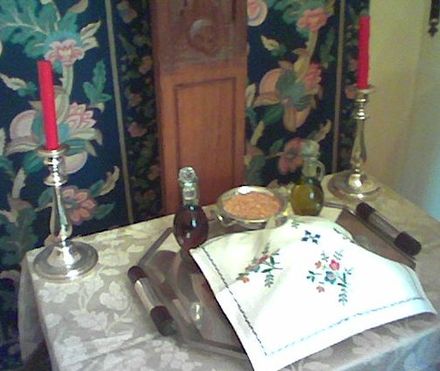
Great Lent, or the Great Fast, is the most important fasting season in the church year in the Byzantine Rite of the Eastern Orthodox Church, Byzantine Rite Lutheran Churches and the Eastern Catholic Churches, which prepares Christians for the greatest feast of the church year, Pascha (Easter).

Vespers is a sunset evening prayer service in the Orthodox, Roman Catholic and Eastern Catholic, Anglican, and Lutheran liturgies of the canonical hours. The word comes from the Greek ἑσπέρα ("hespera") and the Latin vesper, meaning "evening". It is also referred to in the Anglican tradition as evening prayer or evensong. The term is also used in some Protestant denominations to describe evening services.

Divine Liturgy or Holy Liturgy is the Eucharistic service of the Byzantine Rite, developed from the Antiochene Rite of Christian liturgy which is that of the Ecumenical Patriarchate of Constantinople. As such, it is used in the Eastern Orthodox, the Greek Catholic Churches, and the Ukrainian Lutheran Church. Although the same term is sometimes applied in English to the Eucharistic service of Armenian Christians, both of the Armenian Apostolic Church and of the Armenian Catholic Church, they use in their own language a term meaning "holy offering" or "holy sacrifice". Other churches also treat "Divine Liturgy" simply as one of many names that can be used, but it is not their normal term.
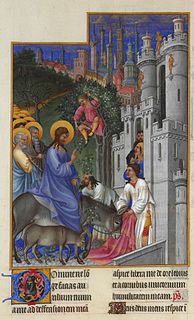
Holy Week in Christianity is the week just before Easter. It is also the last week of Lent, in the West, – Palm Sunday, Holy Wednesday, Maundy Thursday, Good Friday, and Holy Saturday – are all included. However, Easter Day, which begins the season of Eastertide, is not. However, traditions observing the Easter Triduum may overlap or displace part of Holy Week or Easter itself within that additional liturgical period.
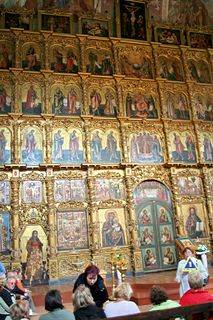
The Byzantine Rite, also known as the Greek Rite or Constantinopolitan Rite, is the liturgical rite used by the Eastern Orthodox Church, the Greek/Byzantine Catholic churches, and in a modified form, Byzantine Rite Lutheranism. Its development began during the fourth century in Constantinople and it is now the second most-used ecclesiastical rite in Christendom after the Roman Rite.
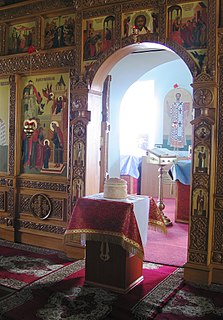
An artos is a loaf of leavened bread that is blessed during services in the Eastern Orthodox and Byzantine rite catholic churches. A large Artos is baked with a seal depicting the resurrection for use at Pascha (Easter). Smaller loaves are blessed during great vespers in a ritual called Artoklasia and in other occasions like feast days, weddings, memorial services etc.

The Liturgy of Preparation, also Prothesis or Proskomedia, is the name given in the Eastern Orthodox Church to the act of preparing the bread and wine for the Eucharist. The Liturgy of Preparation is done quietly before the public part of the Divine Liturgy begins, and symbolizes the "hidden years" of Christ's earthly life.
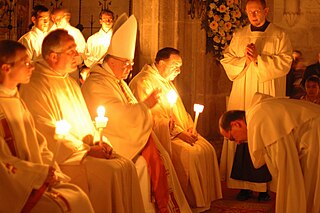
Easter Vigil, also called the Paschal Vigil or the Great Vigil of Easter, is a service held in traditional Christian churches as the first official celebration of the Resurrection of Jesus. Historically, it is during this service that people are baptized and that adult catechumens are received into full communion with the Church. It is held in the hours of darkness between sunset on Holy Saturday and sunrise on Easter Day – most commonly in the evening of Holy Saturday or midnight – and is the first celebration of Easter, days traditionally being considered to begin at sunset.
The Fraction is the ceremonial act of breaking the consecrated bread during the Eucharistic rite in some Christian denominations.
In the Byzantine Rite of the Eastern Orthodox Church and the Eastern Catholic Churches, Orthros (Greek or Oútrenya is the last of the four night offices, which also include vespers, compline, and midnight office. In traditional monasteries it is held daily so as to end at sunrise. In many parishes it is held only on Sundays and feast days. It is often called matins after the office it most nearly corresponds to in Western Christian churches.

A prosphoron is a small loaf of leavened bread used in Orthodox Christian and Greek Catholic (Byzantine) liturgies. The plural form is prosphora (πρόσφορα). The term originally meant any offering made to a temple, but in Orthodox Christianity it has come to mean specifically the bread offered at the Divine Liturgy (Eucharist).

The Divine Liturgy of the Presanctified Gifts is a Byzantine Rite liturgical service which is performed on the weekdays of Great Lent wherein communion is received from Gifts that are sanctified (consecrated) in advance, hence its name; this Divine Liturgy has no anaphora.

In Eastern Orthodox and Byzantine Catholic churches, an entrance is a procession during which the clergy enter into the sanctuary through the Holy Doors. The origin of these entrances goes back to the early church, when the liturgical books and sacred vessels were kept in special storage rooms for safe keeping and the procession was necessary to bring these objects into the church when needed. Over the centuries, these processions have grown more elaborate, and nowadays are accompanied by incense, candles and liturgical fans. In the liturgical theology of the Orthodox Church, the angels are believed to enter with the clergy into the sanctuary, as evidenced by the prayers which accompany the various entrances.

Easter Saturday, on the Christian calendar, is the Saturday following the festival of Easter, the Saturday of Easter or Bright Week. In the liturgy of Western Christianity it is the last day of Easter Week, sometimes referred to as the Saturday of Easter Week or Saturday in Easter Week. In the liturgy of Eastern Christianity it is the last day of Bright Week, and called Bright Saturday, The Bright and Holy Septave Saturday of Easter Eve, or The Bright and Holy Septave Paschal Artos and Octoechoes Saturday of Iscariot's Byzantine Easter Eve. Easter Saturday is the day preceding the Octave Day of Easter.
Acolouthia in the Eastern Orthodox and Eastern Catholic churches, signifies the arrangement of the Divine Services, perhaps because the parts are closely connected and follow in order. In a more restricted sense, the term "acolouth" refers to the fixed portion of the Office. The portions of the Office that are variable are called the Sequences. While the structure and history of the various forms of the Divine Office in the numerous ancient Christian rites is exceedingly rich, the following article will restrict itself to the practice as it evolved in the Eastern Roman (Byzantine) Empire.

The Euchologion is one of the chief liturgical books of the Eastern Orthodox and Byzantine Catholic churches, containing the portions of the services which are said by the bishop, priest, or deacon. There are several different volumes of the book in use.
The Alexandrian Rite is the liturgical rite used by the Coptic Orthodox Church of Alexandria, Eritrean Orthodox Tewahedo Church and Ethiopian Orthodox Tewahedo Church, as well as by the three corresponding Eastern Catholic Churches.
The Liturgy of Saint Basil or, more formally, the Divine Liturgy of Saint Basil the Great, is a term for several Eastern Christian celebrations of the Divine Liturgy (Eucharist), or at least several anaphoras, which are named after St. Basil the Great. Two of these liturgies are in common use today: the one used in the Byzantine Rite ten times a year, and the one ordinarily used by the Coptic Church.

Eastern Orthodox worship in this article is distinguished from Eastern Orthodox prayer in that 'worship' refers to the activity of the Christian Church as a body offering up prayers to God while 'prayer' refers to the individual devotional traditions of the Orthodox.

A liturgical book, or service book, is a book published by the authority of a church body that contains the text and directions for the liturgy of its official religious services.








